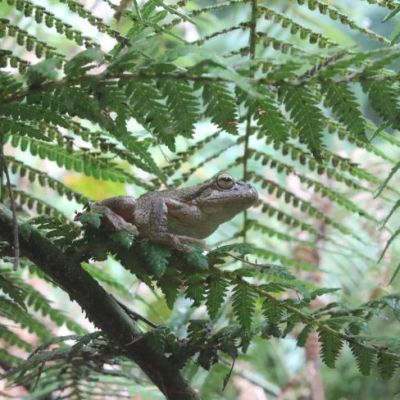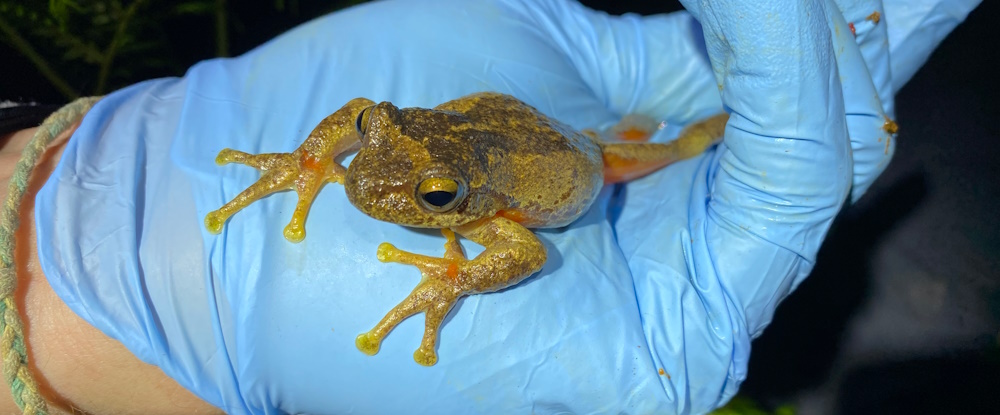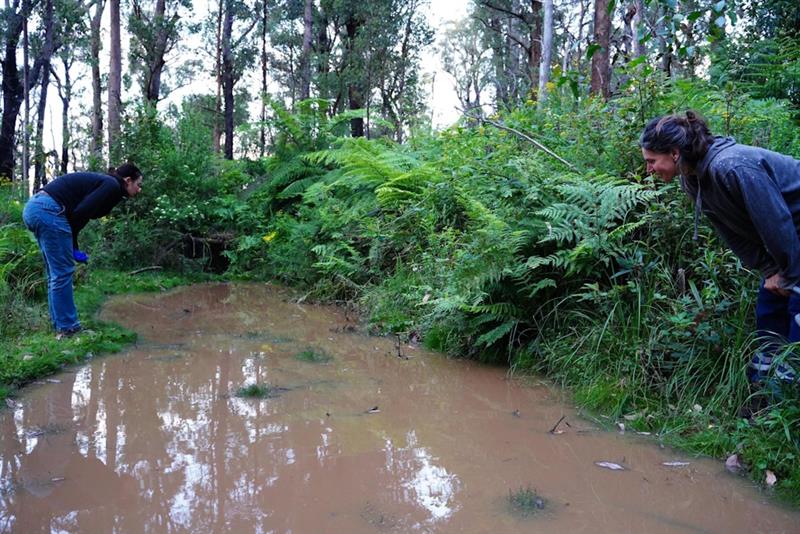In Short
|
Watson’s Tree Frog- photo by Louise Durkin
Victoria’s rediscovered Watson’s Tree Frog
Watson’s Tree Frog (Litoria watsoni) is a forest-dependent tree frog recognisable by the distinct bright orange patches on the back of their legs, groin, and armpits. Listed as nationally endangered, this species is cryptic and rare, making it difficult to find. For 19 years, there were no records of this frog in Victoria, until its rediscovery in 2015.
However, in Victoria the range of Watson’s Tree Frog has contracted and populations appear to be declining. Threats to the persistence of this enigmatic species include the infectious disease Chytrid fungus, habitat loss and degradation, and fragmentation of the species’ populations. These impacts are further exacerbated by the increasing frequency and severity of bushfires due to climate change.
In recent years, Watson’s Tree Frogs have been found breeding in roadside culverts, making them particularly vulnerable to road maintenance activities.
Surveying for Watson’s Tree Frog tadpoles - photo by Lena Schlegel
What we are doing
To help inform the recovery of Watson’s tree frog, ARI is working in collaboration with DEECA Gippsland, Wild Research and Zoos Victoria.
ARI has established an acoustic monitoring program, listening for Watson’s Tree Frog calls at over 80 potential breeding sites throughout the wet forests of Far East Gippsland. With recent advancements using AI to recognise a target species’ call automatically, sites with recent calling can be targeted for survey, with calling frogs captured and genetically sampled.
We are also working towards developing and validating a species-specific eDNA survey tool for Watson’s Tree Frog, as well as screening breeding sites for presence of the Chytrid fungus.
Acoustic monitoring is an emerging tool for ecological surveys of vocalising species. By deploying small recording devices in the field, researchers record many thousands of hours of audio each night for weeks or months, across many sites simultaneously, amassing huge volumes of acoustic data.
Using ARI’s bespoke acoustic processing tools [ARISA and ARIEL], we are using the power of AI to rapidly process these datasets, pinpointing where Watson’s Tree Frogs have been calling.
This method is being employed across over 80 sites in the wet forests of Far East Gippsland to understand when Watson’s Tree Frogs emerge from the forest to call and breed at small ponds.
Environmental DNA (eDNA) monitoring represents a revolutionary new survey method, that takes advantage of the genetic material (DNA) that aquatic animals shed into the environment (e.g. from skin particles, faeces and urine). By collecting water samples from the field, researchers can capture this DNA and use it to detect species presence and potentially estimate their relative abundance.
With the support of a DEECA Icon Species grant, and in collaboration with Wild Research, development and validation of a species-specific eDNA tool for Watson’s Tree Frog detection is underway.
Water samples collected from potential breeding sites throughout the range of Watson’s Tree Frog in Victoria are screened for the presence of DNA of this elusive, cryptic tree frog.
Additionally, sampling these waterbodies throughout the year and screening for the presence of Chytrid fungus spores, is yielding insights into the seasonal prevalence of this deadly amphibian disease.
Acknowledgments
This work was supported by funding from the DEECA Genetic Risk Index development, a DEECA Icon Species grant, and DEECA Forest Fire & Regions division.
Updates from the field
Large rainfall events in early 2025 saw an increase in Watson’s Tree Frog calling activity, with calling confirmed at nine sites. This included two new sites for the species, and three sites where Watson’s Tree Frog was recorded for the first time since the devastating 2019–2020 bushfires.
Encouraged by the success of the acoustic recordings, researchers conducted follow-up fieldwork to locate and capture individuals for genetic sampling and DNA sequencing.
The collected data will help assess the impact of the 2019–2020 bushfires on Watson’s Tree Frog occupancy. It also allows us to compare different survey methods and evaluate how detection varies with factors such as time of year, temperature, antecedent rainfall, and site disturbance history.

More Information
For more information on this project, contact Louise Durkin louise.durkin@deeca.vic.gov.au.
You can watch Louise's presentation from 2022 about her research on this species:
Page last updated: 25/06/25

